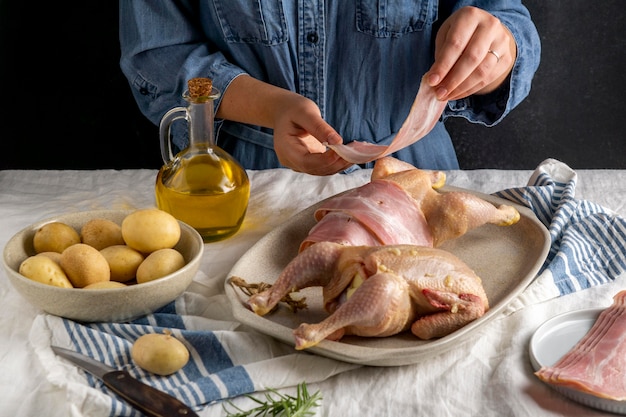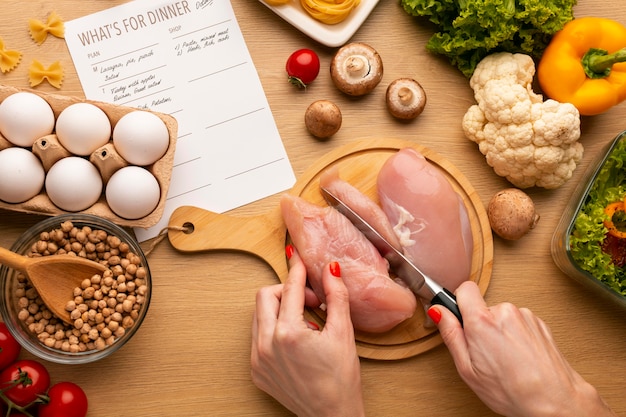(Part 1) Choosing the Right Chicken

The Importance of Freshness
First things first, let's talk about the chicken itself. You want a fresh, high-quality bird. It's the key to a really delicious roast. If you can, head to your local butcher and ask for a whole chicken that hasn't been frozen. They'll usually have a good selection of free-range or organic options too, which are generally a bit tastier. Just make sure it's been chilled properly and doesn't smell strange - trust your nose!
Size Matters
The size of your chicken is important too. For a family of two or three, a 1.5kg chicken is a good bet. If you're feeding a bigger crowd, a 2kg or even 2.5kg bird might be necessary. Don't worry about it being too big, it just means more leftovers for sandwiches!
How to Choose a Good Bird
Here's a quick checklist to ensure you've picked the perfect bird:
- Check the skin. It should be firm and smooth, with no tears or cuts.
- Give it a good sniff. It should smell clean and fresh, not sour or funky.
- Check the packaging date. You want to make sure it's been chilled properly and hasn't been sitting around too long.
- If you're buying a frozen chicken, ensure the packaging is intact, and the chicken hasn't been frozen for too long.
(Part 2) Preparing the Chicken

Patting It Dry
Now you've got your chicken home, it's time to get it ready for roasting. The first step is to pat it dry with kitchen paper. This helps to create that crispy skin we all crave and prevents the chicken from steaming in the oven.
Brining: The Secret to juicy chicken
Here's a little trick to make your chicken extra juicy: brining. It involves soaking the chicken in a salt water solution, which helps to keep the meat moist and tender. Here's what you need:
- 4 cups of water
- 1/2 cup of kosher salt
- 1/4 cup of sugar
Simply combine the water, salt, and sugar in a large bowl and stir until the salt and sugar are dissolved. Then, add the chicken, making sure it's fully submerged in the brine. Cover the bowl and refrigerate for at least 4 hours, or up to 8 hours.
I know it might seem like an extra step, but trust me, brining is worth the effort. You'll be amazed by how much juicier and more flavourful your chicken will be.
Don't Forget the Herbs and Spices
Now, it's time to get creative with herbs and spices. I love using a mix of rosemary, thyme, and garlic for my roast chicken. But you can experiment with whatever you like. Just make sure you season the chicken generously, both inside and out.
Here are some of my favourite spice combinations for roast chicken:
- Classic: Rosemary, thyme, garlic, and black pepper for a classic flavour.
- Spicy: Paprika, cumin, oregano, and chili flakes for a kick.
- Mediterranean: Lemon zest, oregano, and garlic for a bright and fresh flavour.
- Indian-inspired: Coriander, ginger, and turmeric for a warm and aromatic flavour.
(Part 3) Stuffing the Bird

What to Stuff Your Chicken With
Stuffing is a great way to add flavour and moisture to your roast chicken. There are endless possibilities when it comes to stuffing, but here are a few of my favourites:
- Bread-based stuffing: Combine breadcrumbs, herbs, vegetables like onions, celery, and carrots, and some stock for a classic stuffing.
- Sausage stuffing: Use crumbled sausage meat, herbs, and onions for a rich and savoury stuffing.
- Citrus stuffing: Mix citrus fruits like lemon, orange, and grapefruit with herbs, spices, and bread for a refreshing stuffing.
- wild rice stuffing: Wild rice, dried cranberries, pecans, and herbs are a great option for a festive stuffing.
- Mushroom stuffing: Sauteed mushrooms, onions, garlic, and herbs make for a delicious and earthy stuffing.
Stuffing Tips
Here are a few tips for stuffing your chicken:
- Don't overstuff the chicken. Leave some room for the stuffing to cook evenly.
- Make sure the stuffing is cooked through before serving. You can check this by inserting a meat thermometer into the thickest part of the stuffing. The temperature should reach 165°F (74°C).
- If you're worried about the stuffing being undercooked, you can cook it separately in a baking dish alongside the chicken.
(Part 4) Roasting the Chicken
Preheating the Oven
Preheat your oven to 350°F (175°C). This will help the chicken cook evenly and ensure the skin gets nice and crispy.
Using a Roasting Rack
Place the chicken on a roasting rack, which will help the air circulate around the chicken, allowing it to cook evenly and prevent it from sitting in its own juices.
Positioning the Chicken
Place the chicken in the middle of the oven, on a baking sheet to catch any drippings. It's a good idea to have the chicken positioned on the middle rack so it gets cooked evenly.
roasting time
The roasting time will vary depending on the size of your chicken. Here's a general guide:
| Chicken Weight | Roasting Time |
|---|---|
| 1.5kg | 1 hour 30 minutes |
| 2kg | 1 hour 45 minutes |
| 2.5kg | 2 hours |
It's always a good idea to check for doneness a little earlier than expected, just to be safe.
Checking for Doneness
To check if the chicken is cooked through, insert a meat thermometer into the thickest part of the thigh. The temperature should reach 165°F (74°C).
You can also check the doneness by pressing on the thigh. If it's firm to the touch, it's cooked through.
(Part 5) Resting the Chicken
Why It's Crucial
Once the chicken is cooked, it's important to let it rest for at least 10 minutes before carving. This allows the juices to redistribute throughout the meat, resulting in a much more succulent and flavorful chicken.
(Part 6) Carving the Chicken
A Simple Approach to Carving
Carving a whole chicken can seem intimidating, but it's really quite simple. Here's how to do it:
- Place the chicken on a cutting board.
- Use a sharp carving knife to cut down one side of the breastbone.
- Cut the legs off by slicing through the joint between the thigh and the drumstick.
- Separate the thigh and drumstick by cutting through the joint.
- Slice the breast meat into pieces.
If you're feeling fancy, you can try carving the chicken with a whole roast chicken carving tool. It has a special curved blade and can be found in most supermarkets or kitchen stores.
(Part 7) Serving the Roast Chicken
side dishes
Roast chicken goes well with a variety of side dishes. Here are a few ideas:
- roast vegetables: Potatoes, carrots, and parsnips are classic companions.
- Green salad: A refreshing contrast to the richness of the chicken.
- Gravy: Made from the chicken drippings for a delicious and flavorful sauce.
- Stuffing: If you chose to stuff the chicken, it makes a perfect accompaniment.
- Cranberry sauce: A festive addition, especially during the holidays.
- roasted brussels sprouts: A delicious and healthy side dish.
- Mashed sweet potatoes: A creamy and comforting side dish.
- Wild rice pilaf: A nutty and flavorful side dish.
Making Gravy
To make gravy, simply pour the drippings from the baking sheet into a saucepan. Bring to a simmer and whisk in some flour. Continue to whisk until the gravy thickens. Season with salt and pepper to taste.
You can also add a splash of red wine or chicken stock to the gravy for extra flavour.
(Part 8) Storing Leftovers
Keeping it Fresh
leftover roast chicken can be stored in the refrigerator for up to 3 days. You can reheat it in the oven or microwave.
Leftover roast chicken is great for making sandwiches, salads, or soups. I often use it for a hearty chicken salad sandwich or a comforting chicken noodle soup.
FAQs
1. What are some alternatives to brining?
If you don't have time to brine your chicken, you can try dry-brining instead. This involves rubbing the chicken with salt and pepper and letting it sit in the refrigerator for several hours. It's a great option if you're short on time, but it won't be as effective as traditional brining.
2. Can I use a different type of bird?
Yes, you can use other types of poultry, such as turkey or duck, but the cooking time will vary. Be sure to check the cooking instructions on the packaging.
3. Is it safe to stuff a chicken with raw stuffing?
It is not recommended to stuff a chicken with raw stuffing, as this can lead to food poisoning. It's best to cook the stuffing separately in a baking dish.
4. What if the skin isn't crispy?
If your chicken skin doesn't get crispy, you can try these tips:
- Pat the chicken dry before roasting. This helps to ensure the skin is as dry as possible, which encourages crispiness.
- Roast the chicken at a higher temperature. A higher temperature will help to crisp up the skin more quickly.
- Don't overcrowd the pan. Make sure the chicken has plenty of space to cook evenly.
- Try flipping the chicken halfway through. This can help to ensure that both sides of the chicken get crispy.
5. How can I tell if the chicken is done?
The best way to check if the chicken is done is to insert a meat thermometer into the thickest part of the thigh. The temperature should reach 165°F (74°C).
You can also check the doneness by pressing on the thigh. If it's firm to the touch, it's cooked through.
There you have it - your ultimate guide to cooking a juicy, flavorful whole chicken. Give it a go and let me know how you get on!
Everyone is watching

Prime Rib Roast Cooking Time Chart: Per Pound Guide
Cooking TipsPrime rib roast. Just the name conjures images of lavish dinners, crackling fires, and hearty laughter. It’s ...

How Long to Bake Potatoes in the Oven (Perfect Every Time)
Cooking TipsBaked potatoes are a staple in my kitchen. They're incredibly versatile, delicious, and surprisingly easy to m...

Perfect Rice Every Time: The Ultimate Guide to Cooking Rice
Cooking TipsAs a self-proclaimed foodie, I've always been a bit obsessed with rice. It's the foundation of countless cuisi...

The Ultimate Guide to Cooking Asparagus: Tips, Techniques, and Recipes
Cooking TipsAsparagus. The mere mention of this spring delicacy conjures up images of vibrant green spears, crisp and burs...

Ultimate Guide to Cooking the Perfect Thanksgiving Turkey
Cooking TipsThanksgiving. Just the word conjures up images of overflowing tables laden with delicious food, the scent of r...
